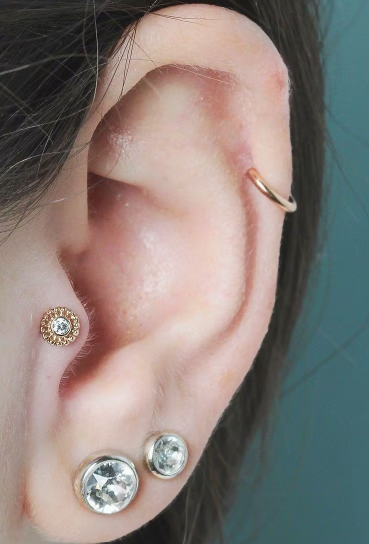Sleeping on a freshly pierced ear can come with risks. In fact, when you get a new ear piercing, several effects can occur on the skin and surrounding areas. Swelling, inflammation, growths, redness, and even scabbing are the most common effects. In this article, we will detail the risks of sleeping on a freshly pierced ear and provide you with solutions.
Risks associated with sleeping with a new ear piercing
Ear piercings are very popular, however, some risks of infection, inflammation or even growths are present. One of the often overlooked factors for good ear piercing healing is sleep. In fact, sleeping in a freshly made ear piercing can cause certain risks.
1- Inflammations in new ear piercing
After a new piercing, swelling is a normal reaction. You may notice that the area is red, warm, and swollen. Over time, this swelling could even evolve to give an itchy sensation, which means the healing process is underway. Although these symptoms are typical, it is vital to keep a watchful eye and consult a professional if the swelling seems to last longer than usual.
2- Infections in new ear piercing
It is crucial to differentiate between inflammation and an infection. If you notice a yellow-green discharge or experience excessive pain around your piercing, this could indicate an infection. In such a case, it is highly recommended to consult your piercer or a doctor as soon as possible. Keep in mind that clear discharge is common during inflammation, so do not immediately mistake it for an infection.
3- The bumps
Sleeping on your new ear piercing can lead to bumps, including keloids. A keloid is a form of exaggerated scarring that often develops long after the initial healing. It does not form directly after the act of piercing, but more than a year after the piercing.
Keloids develop from injuries to the skin. In the case of a piercing, they often form when there is pressure and/or friction from the piercing. The bumps often form during sleep. They can also appear when a piercing is snagged or a sudden movement is made.
Sleeping with a new ear piercing: the solutions
Finding ways to sleep comfortably while caring for your new piercing can sometimes be difficult. Here are three solutions to promote good healing while you sleep.
1- Adopt a proper sleeping position
Getting a new ear piercing requires a proper sleeping position that minimizes friction or pressure against your pillow. Here are some tips:
- Sleeping on your back for better healing: This position reduces the risk of friction and pressure against your pillow. Sleeping on your back, if possible, is one of the first solutions you should consider. If you find it difficult to sleep on your back, try sleeping on your side.
2- Prioritize strict hygiene
Getting a new piercing requires strict hygiene to avoid any risk of inflammation, irritation, infection, etc. Maintaining good hygiene also improves the healing of your piercing. Here are three tips to follow when you are going to get a new piercing:
- Wash your hands before touching your new ear piercing: Washing your hands is an important step in maintaining good hygiene. Hands contain a lot of bacteria that can penetrate the tissues of your new piercing. Don't hesitate to wash your hands with antibacterial soap. Then, before moving on to the cleaning stage, keep your saline solution cold and apply it with a sterile gauze.
- Clean your new ear piercing regularly but carefully: Before going to bed, clean and dry your ear piercing. Cleaning and drying your piercing helps prevent maceration that encourages the growth of bacteria. For optimal cleaning, use a saline solution recommended by your piercer or physiological serum. Avoid any aggressive products such as alcohol, disinfectant or hydrogen peroxide. Also use a sterile gauze to dry your piercing.
- During the healing period, avoid regularly touching or rotating your ear piercing, even while cleaning it. During the day, your hands come into contact with a lot of bacteria and you may not have the opportunity to clean them with appropriate products throughout the day.
3- Use appropriate pillows
An interesting solution to protect your ear piercing while sleeping is the use of suitable pillows. Here is a list of pillows:
- Use a U-shaped travel pillow. Pillows of this shape are specifically designed so that your ear does not touch the pillow thanks to an opening.
- Opt for a perforated pillow: These pillows provide you with comfort during your sleep. They are designed with a ridge or a hole in the center. This allows you to sleep without putting pressure on your ear.
Do not hesitate to consult a professional in case of complications or persistent inflammation. Discover without further delay our body-friendly and life-resistant jewelry
Read More:: What is helix piercing?




Leave a Reply